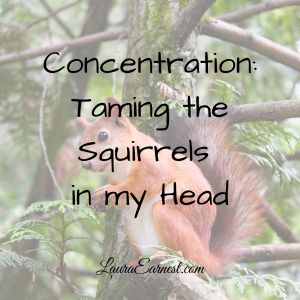I believe that focus is not just about eliminating the distractions of the squirrels in my head; it also has to do with having a strong concentration muscle.
The ability to focus is not just limited to not being interrupted. It is also dependent on the mind’s ability to stay on track. I think a lot of the talk that is going on right now is focusing on the interruptions and minimizing them. And this is a good first step. But in order to truly focus, you have to be able to stretch your concentration.
Concentration, Endurance and Percussion
I have known for some time that my concentration levels are not what they used to be. I have always blamed the amount of distraction that is going on around me.
A few weeks ago my percussion teacher assigned me an exercise known as the “Stone Killer”. It’s purpose is to build, by repetition, speed and endurance of single-stroke sticking.
My teacher told me to repeat each line 50 (yes you read that right) times. The whole exercise would take about 15 minutes.
I didn’t mind the repetition count, and I didn’t protest. I have done this sort of exercise before to build muscle memory and speed – my college flute professor had us playing scales starting on the lowest note of the flute to the highest and repeating the scales starting on every note of the octave. It’s boring as heck, but very effective.
So I started on my practice. RRRR LLLL RRRR LLLL RRRR LLLL…what number was I on?
It became apparent to me that the endurance I was going to build was not just physical, but also mental. Because I had lost the ability to focus and count 50 measures of repeated pattern.
This was pretty horrifying to me. One of the things required as an ensemble musician is the ability to count measures. Granted, I don’t do ensemble work right now, but it was shocking evidence of my inability to concentrate.
I told my instructor about the mental endurance, and jokingly said I blame my phone. He told me he had seen a similar deterioration in himself during COVID, when he had spent a lot more time on his phone. He didn’t hesitate to blame his phone.
Two Sides of the Same Coin
Most of the articles I found during my research talked about increasing focus by limiting distraction. And that is a very important part of the process.
It’s impossible to concentrate – to even start – if there are things buzzing, beeping, interrupting your train of thought, waving for your attention. You have to be able to limit the distractions, no matter which of your senses they are capturing. Sight, sound, smell, touch, taste…all can be distracting, and every effort must be made to minimize these.
I also believe that in order to truly focus, you have to have a strong concentration muscle. Like any other muscle, it can be trained and strengthened. This is where the true focus comes in: the ability to not only ignore your senses, but also to make your mind laser in on something and stay there.
The Three Types of Concentration
Concentration is centered in the brain, and there are three different types of mind energy that fall into this classification.
- Engaging the mind: this is the ability to stay engaged on one topic for long periods of time.
- Emptying the mind: this is the ability to let thoughts float through without engaging them.
- Daydreaming: allowing the brain to go where it wants to without trying to direct it.
Each of these requires a different set of concentration skills: the first to focus on something specific; the second to focus on nothing; and the third to focus on observation.
Increasing concentration
I believe that concentration is like a muscle. And like any muscle it can be strengthened. It takes dedicated practice to increase the types of concentration, but there are proven ways to make it happen.
Engaging the Mind Practice
Music
If you are a musician, this type of practice is easy. Most musical instruments have exercises that are designed to increase flexibility of hands and muscle memory. If you’re a percussionist, this can be in the form of the Stone Killer Exercise. If you play flute, Trevor Wye’s book on technique* will do the trick.
And if you can’t find anything, do the scale exercise my flute professor assigned: pick a key and start on the lowest note of your instrument, and play a scale all the way to the highest (note: you may not be starting on the tonic of the scale). Move up a single note at a time, still in the same key, until you do the full octave. Then move to the next key in the circle of fifths.
Athletics
Work on your endurance by repeating the same exercise over and over. Count each repetition. This could be free throws, serves, hitting a baseball, even tossing cornhole bags. If you are walking, count the number of steps and groups of steps using some non-typical grouping like 3, 5 or 7. Of course, always be aware of your surroundings as you do this so you don’t injure yourself.
Crafting/Creative
Engage in your hobby with deliberate intention. Count the number of stitches or paintbrush strokes made. You can even count the number of stirs you are giving a cake batter!
Games
There are games on the market that will help you increase your concentration. Brain Training is available on multiple platforms. Even the 70s Simon* game can help you engage (and it comes in a smaller version* now too!)
Emptying the Mind Practice (aka Meditation)
Meditation comes in many different formats, but to practice emptying the mind, you must pick one that isn’t a guided meditation that will engage your ind..
Breath meditation is good for a beginner. You focus on your inhale/exhale and let any thoughts just float through. Having a sound or word can help increase the focus.
Make sure that you aren’t lying down when you do meditation practice. This can often lead to falling asleep! But as a meditation teacher I once had told me: it’s OK to fall asleep because your body must need the rest.
Visualization can also help take the mind to the next level of emptying.
Even some of the meditation apps, like Calm, can assist with the breath and emptying meditations.
Daydreaming Practice
Daydreaming practice seems counter-intuitive if we are trying to build concentration. After all, we’re trying to contain the squirrels, not let them take over.
But daydreaming allows our mind to make connections between ideas and thoughts that it might not if we were directing its flow. It’s great for creativity, and allows us to have a break from other concentration and distraction avoidance.
The difference between daydreaming and typical mind squirrels is that we usually try to silence and still the squirrels. During daydreaming, we let our squirrels frolic and observe what they do.
Daydreaming can be done sitting or walking. And it has loads of benefits outside of increasing concentration – even helping us avoid negative behavior.
Build Those Concentration Muscles!
Building your concentration muscle is just as important as learning to deal with distractions on the quest for focus. Remember that concentration can be built. Just take it slow, and don’t be upset if you can’t go for long. Like any muscle-building activity, endurance comes with practice and time.







